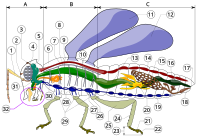
Photo from wikipedia
Abstract There is noticeable variation in male mate-seeking behavior among species of Brassolini butterflies. Males of Opsiphanes Doubleday and Caligo Hübner (Lepidoptera, Nymphalidae) species perform crepuscular displays along forest edges… Click to show full abstract
Abstract There is noticeable variation in male mate-seeking behavior among species of Brassolini butterflies. Males of Opsiphanes Doubleday and Caligo Hübner (Lepidoptera, Nymphalidae) species perform crepuscular displays along forest edges and in light gaps. While male Opsiphanes perform aerial displays, Caligo males perch and wait for receptive females. A comparison of five species of each genus suggests that male display behavior is associated with, and has likely influenced the evolution of their wing attributes and body design. Opsiphanes males have higher wing aspect ratio and more distal centroid position than congeneric females, suggesting that the energetic demands of aerial displays led to sexual dimorphism in wing morphology. In contrast, male and female Caligo generally showed similar wing morphology, which possibly results from the lower energy expenditure of perching behavior when compared with active flight. Likely due to a genetic correlation between sexes, female Opsiphanes and Caligo are more similar in wing morphology and body design to their congeneric males than to each other. Based on our analyses, we make predictions about reproductive behavior for four species in which male mating displays are unknown.
Journal Title: Annals of the Entomological Society of America
Year Published: 2020
Link to full text (if available)
Share on Social Media: Sign Up to like & get
recommendations!